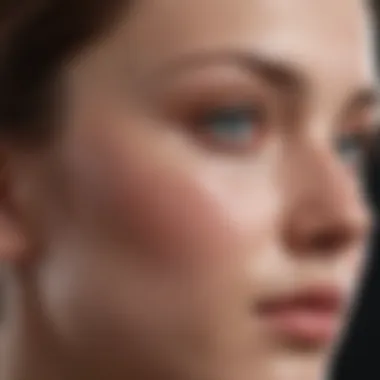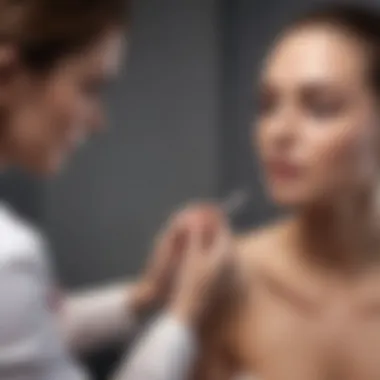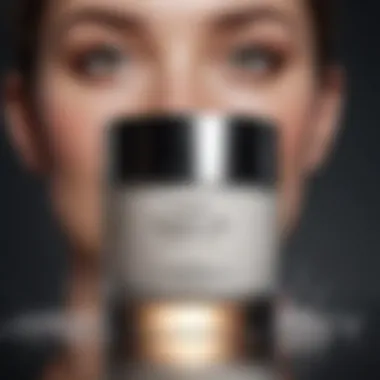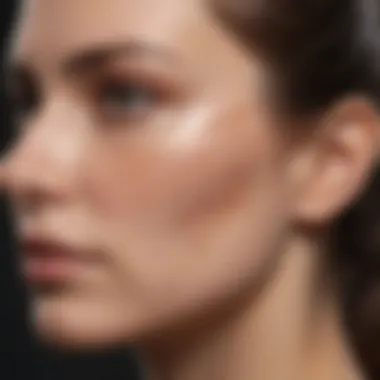Should You Pop a Whitehead? Expert Insights and Advice


Intro
The question of whether to pop a whitehead has intrigued many. A whitehead, caused by clogged pores, can be both bothersome and tempting. Understanding the science behind this common skin issue is crucial. Not only does it impact your appearance, but it also shapes your skincare routine and your skin's health.
Many grapples with the urge to pop these blemishes, often driven by a desire for immediate resolution. However, this impulse can lead to unintended consequences. It’s vital to weigh the risks against the benefits. This article elucidates the topic by discussing causes, risks, expert recommendations, and effective skincare practices.
Trending Topics
The Rise of Skincare Science
In recent years, there has been an increased interest in skincare. Consumers are more informed about ingredients and their effectiveness. New research on skin health contributes to this knowledge. Products featuring salicylic acid and niacinamide are particularly lauded for addressing whiteheads.
Popularity of DIY Skincare Remedies
Given the desire for immediate results, many turn to DIY remedies. However, not all home methods are safe or effective. Many professionals recommend caution when considering these options. Understanding which ingredients are beneficial is key for maintaining healthy skin.
Understanding Whiteheads
Whiteheads are a type of acne formed when oil and dead skin cells block hair follicles. They can occur on various parts of the body, but are most common on the face. Knowing what causes them aids in prevention.
Common Causes
- Hormonal Changes: Fluctuations during menstruation or puberty can manifest as whiteheads.
- Excess Oil Production: Overactive sebaceous glands contribute to clogged pores.
- Bacterial Activity: The presence of certain bacteria on the skin can exacerbate breakouts.
- Diet and Lifestyle: High-glycemic foods and stress levels can impact skin health.
Risks of Popping
Popping whiteheads is often tempting, but doing so may have drawbacks.
Potential Consequences
- Infection: Introducing bacteria into the open pore can lead to deeper skin infections.
- Scarring: Improper technique can cause lasting marks on the skin.
- Worsening of Acne: Disruption within the pore might lead to more stubborn forms of acne.
"Avoid popping whiteheads to preserve skin integrity and minimize risks."
Expert Recommendations
Professionals typically advise against self-extraction. Instead of popping, they recommend gentle skin care routines. Using non-comedogenic products helps prevent blockages and maintain healthy skin. Regular cleansing and exfoliation can minimize the appearance of whiteheads.
Finale
Deciding whether to pop a whitehead necessitates careful consideration. Understanding the underlying causes and associated risks is essential. Following expert recommendations can protect skin health and prevent further issues. With proper care, individuals can maintain beautiful skin without the need for hasty measures.
Understanding Whiteheads
Understanding whiteheads is critical to managing acne effectively. Whiteheads, a common form of acne, often cause distress due to their visibility and persistence. This section will explore key elements that shape the understanding of whiteheads.
First, knowing what whiteheads are helps in identifying them correctly. This knowledge is vital for anyone dealing with skin issues. Furthermore, understanding their causes enables individuals to take proactive steps in managing their appearance and preventing future breakouts.
Another important aspect to consider is how whiteheads differ from other types of acne. Recognizing this distinction helps inform proper treatment options and encourages informed decisions regarding skincare routines.
In summary, grasping the nuances of whiteheads will equip readers with the insight necessary to approach their skincare with confidence and awareness.
Definition of Whiteheads
Whiteheads are closed comedones, which form when hair follicles become clogged with dead skin cells, sebum, and bacteria. The closed nature of whiteheads causes them to appear as small white bumps on the skin's surface. Unlike blackheads, which are open to the air and oxidize, whiteheads maintain a white or flesh-colored appearance due to the plug being sealed beneath the skin.


They typically appear on various regions of the face, particularly the forehead, nose, and chin, known as the T-zone. However, they can also form on the back and shoulders.
Causes of Whiteheads
The development of whiteheads can be attributed to several factors:
- Hormonal changes: Fluctuations during puberty, menstruation, and pregnancy can trigger increased oil production.
- Excessive oil production: Sebaceous glands produce sebum that can clog pores.
- Dead skin cells: If the skin fails to shed its dead cells effectively, these can accumulate and block pores.
- Bacteria: The presence of Propionibacterium acnes, a bacteria that thrives in clogged pores, can lead to inflammation.
- Diet: Certain dietary choices, like high glycemic index foods, may contribute to acne flare-ups.
Understanding these causes aids individuals in recognizing personal triggers and adopting appropriate preventative measures.
Whiteheads vs. Other Types of Acne
Whiteheads are one specific manifestation of acne, but they share the skin space with other types. The main distinctions include:
- Blackheads: Open comedones that appear dark at the surface due to oxidization.
- Papules: Small red bumps that may be tender, indicating inflammation.
- Pustules: Similar to papules but filled with pus, often red at the base and the white head present at the top.
- Cysts: Large, painful lumps under the skin that can be filled with pus.
Recognizing these differences allows individuals to understand the severity of their condition and decide on the best course of action for treatment.
"Proper identification of whiteheads compared to other acne types is essential for effective treatment."
The Risks of Popping Whiteheads
Popping a whitehead may seem like a quick fix to achieve smooth skin, but this practice can pose serious risks. Understanding these dangers is essential for anyone considering self-extraction of acne. Not only can popping a whitehead complicate the healing process, it can also lead to permanent damage. In this section, we will explore the potential risks that accompany this common beauty practice, emphasizing the importance of knowledgeable skincare management.
Potential for Scarring
When a whitehead is popped, it creates an open wound on the skin. This can lead to skin damage, which may result in scarring. Scars can be difficult to remove and often remain visible long after the whitehead has healed. The likelihood of scarring varies depending on skin type, the depth of the injury, and individual healing processes. Individuals with darker skin tones may be particularly prone to hyperpigmentation as a result of inflammation from squeezing a whitehead.
- Types of scars:
- Hypertrophic scars: Raised scars that develop due to excess collagen production.
- Atrophic scars: Indented scars that result from loss of tissue.
- Keloid scars: Thick, raised scars that grow beyond the boundaries of the original injury.
Risk of Infection
In addition to scarring, there is a significant risk of infection when popping a whitehead. The skin’s barrier becomes compromised when the pore is forcibly opened. Bacteria can enter the wound, leading to infections that may require medical treatment. Signs of infection include increased redness, warmth, swelling, and pus formation. In some cases, systemic symptoms like fever can manifest, indicating a more serious complication. Proper hygiene before any facial manipulation is crucial, yet many tend to overlook this aspect.
Most skin experts advise against popping whiteheads to prevent both scarring and infection.
Inflammation and Further Breakouts
Popping a whitehead can cause additional inflammation in the surrounding tissues. This inflammation can lead to more breakouts as the skin reacts to trauma. The cycle may continue, with new whiteheads forming as the skin seeks to heal itself. Furthermore, the act of squeezing can force the contents of the whitehead deeper into the skin, potentially leading to cystic acne down the line. Therefore, resist the impulse to pop and consider alternative methods to handle breakouts effectively.
In summary, the risks associated with popping a whitehead are multifaceted. From scarring to infection and exacerbation of existing acne, these dangers serve as a compelling argument against self-extraction. Proper skincare strategies should be prioritized over impulsive actions to ensure healthier, clearer skin.
When Is It Safe to Pop a Whitehead?
Understanding the right circumstances for popping a whitehead is crucial for maintaining skin health. While self-extraction may seem like a quick solution, it is imperative to approach this action with caution. Knowing when it is appropriate to pop a whitehead can prevent more significant skin issues, such as infection or scarring. Readers should educate themselves on this topic as it equips them to make more informed decisions concerning their skin.
Identifying Ripeness
Before attempting to pop a whitehead, it is essential to assess its ripeness. This means examining the whitehead for specific signs that indicate it is ready for extraction. A ripe whitehead typically appears as a raised bump with a visible white or yellow center. The surrounding skin may be slightly red, indicating some inflammation. If the whitehead has a hard texture or does not have a distinct white tip, it is generally better to leave it alone.
Patience is crucial; not all whiteheads reach an optimal state for popping. Trying to pop a whitehead prematurely can lead to complications.
Hygiene Practices Before Extraction


Adhering to stringent hygiene practices is non-negotiable before attempting to pop a whitehead. Cleanliness minimizes the risk of infections that can arise from unsterile environments. Here are some steps to follow:
- Wash your hands thoroughly with soap and warm water.
- Disinfect the extraction tool, if using one, with alcohol.
- Cleanse your face with a gentle cleanser to remove oil and bacteria.
- Apply steam to your face or use a warm towel for several minutes to help open the pores.
By taking these precautions, you can create a cleaner environment for the extraction process, reducing the likelihood of complications.
Proper Techniques for Popping Whiteheads
If the conditions are right, and you feel ready to proceed, using the proper technique is vital. Improper methods can increase the risk of irritation or further breakouts. Here are some recommended techniques:
- Use a sterile tool: If using a comedone extractor, ensure it is clean. Avoid using fingers directly.
- Position the tool correctly: Place the extractor around the whitehead; avoid applying excessive pressure.
- Gentle pressure: Apply light pressure without forcing the whitehead. If it resists, stop.
- Clean the area afterward: After successful extraction, clean the area with a mild antiseptic to minimize the possibility of infection.
"Safe extraction practices can mitigate the risks while potentially providing immediate relief."
By adhering to these protocols, individuals can make the most informed choices about popping whiteheads, fostering better skin health outcomes.
Alternative Treatments
Considering the various approaches to managing whiteheads, exploring alternative treatments can offer individuals a wide range of options. Each method provides distinct benefits and may cater to different needs or skin types. Understanding these alternatives can help in making informed decisions about skincare.
Topical Treatments
Topical treatments remain a popular choice for managing whiteheads. They are easily accessible and often available over the counter. Common ingredients in these treatments include:
- Salicylic acid: This beta hydroxy acid penetrates deep into the pores to help exfoliate and clear away dead skin cells, preventing clogged pores.
- Benzoyl peroxide: It is effective at killing acne-causing bacteria and reducing inflammation, thus minimizing the risk of developing new whiteheads.
- Retinoids: Ingredients like adapalene promote cell turnover and prevent the formation of new blemishes, thereby keeping skin healthier over time.
When selecting a topical treatment, it is essential to match the product to your skin type. For example, those with sensitive skin may prefer milder options or formulations that combine multiple benefits in lower concentrations.
Professional Extraction
For individuals hesitant to pop a whitehead themselves, professional extraction by a dermatologist offers a safe alternative. Trained professionals utilize sterile tools and techniques to remove whiteheads effectively, thereby reducing the risk of scarring or infection. Key benefits of this method include:
- Reduced risk of complications: A dermatologist can extract whiteheads without causing harm to surrounding skin.
- Immediate results: Professional treatments often lead to quick improvements in appearance, offering instant relief from visible blemishes.
- Customized aftercare: A dermatologist can suggest personalized skincare recommendations based on individual skin types and conditions, promoting long-term health.
Opting for professional extraction may also help in managing ongoing acne issues, as dermatologists can assess underlying causes and suggest targeted treatments.
Natural Remedies
Natural remedies are an attractive option for individuals seeking less invasive treatments for whiteheads. These solutions often involve common household ingredients and encourage gentle skincare practices. Some popular remedies include:
- Tea tree oil: Known for its antibacterial properties, it can be applied directly to affected areas to reduce inflammation and kill bacteria.
- Aloe vera: Its soothing properties help calm inflamed skin and provide moisture without clogging pores.
- Honey: Its natural antibacterial qualities make it an effective treatment. Applying a thin layer on affected areas can promote healing.
While natural remedies may not yield immediate results, they often improve overall skin health over time. However, it is important to perform a patch test prior to full application to ensure no allergic reactions occur.
"Using alternative treatments can be a mindful approach to skincare, promoting holistic well-being and reducing the risks often associated with harsher methods."
Preventing Whiteheads
Preventing whiteheads is a crucial aspect of skincare that directly impacts skin health and appearance. Addressing the factors that contribute to whitehead formation can save time, effort, and discomfort associated with acne treatment. When whiteheads are prevented, individuals can maintain smoother skin and boost their confidence. This process centers around a holistic approach that combines skincare routines, dietary choices, and lifestyle habits.
Skincare Routine Essentials
A dedicated skincare routine is foundational in the prevention of whiteheads. It involves daily practices that keep the skin clean and balanced. Essential elements include:
- Cleansing: Use a gentle cleanser twice daily to remove dirt and excess oil. Look for ingredients like salicylic acid or benzoyl peroxide, which help to unclog pores.
- Moisturizing: Keep the skin hydrated with an oil-free moisturizer. Even oily skin needs moisture to function correctly.
- Exfoliating: Regular exfoliation encourages the shedding of dead skin cells. Two to three times a week is usually enough. Choose chemical exfoliants over physical ones to avoid irritation.
- Sun Protection: Always apply a broad-spectrum sunscreen daily. Sun damage can worsen skin issues, leading to increased oil production and clogged pores.


Maintaining consistency in these routines is key. Expecting results too quickly can lead to frustration, which may tempt users to try harsher treatments that can exacerbate problems.
Dietary Considerations
Diet plays a significant role in skin health. Certain foods can exacerbate acne, while others can promote clear skin. To help prevent whiteheads, focus on:
- Balanced Diet: Incorporate plenty of fruits and vegetables. Foods rich in antioxidants help combat free radicals.
- Omega-3 Fatty Acids: These can reduce inflammation and are found in fatty fish like salmon and in flaxseeds.
- Limit Sugars and Processed Foods: High-glycemic foods may increase insulin levels and hormone production, leading to more sebum. Monitor your intake of white bread, sweets, and sugary drinks.
Making informed dietary choices can significantly impact skin clarity. Keeping a food journal might help identify which foods correlate with skin flare-ups.
Lifestyle Modifications
Lifestyle plays a role in skin condition, including factors like stress management and hygiene practices. Consider these modifications for clearer skin:
- Stress Reduction: Practice mindfulness or yoga. Stress can lead to hormonal changes that promote acne.
- Regular Exercise: Physical activity increases blood circulation and helps detoxify the skin. Be sure to cleanse the face after workouts to remove sweat and dirt.
- Avoid Touching the Face: Frequent touching can transfer bacteria and oils from the hands to the face, contributing to breakouts.
- Quality Sleep: Aim for 7-9 hours of quality sleep per night. Sleep is essential for skin repair and overall health.
These simple lifestyle changes can contribute significantly to preventing whiteheads and support an overall healthy skin routine.
It's important to remember that consistent preventative measures can lead to significant improvements in skin health over time.
Consulting a Dermatologist
Consulting a dermatologist is a critical step in addressing skin issues, particularly when it comes to stubborn whiteheads. A dermatologist specializes in skin health, making them uniquely qualified to provide tailored advice and treatments. This section of the article highlights the importance of engaging a dermatologist.
Dermatologists offer benefits that go beyond simple advice. Their expertise in recognizing different types of acne can lead to more accurate diagnoses. This helps in distinguishing whiteheads from other acne forms. They can also help identify underlying issues that might be contributing to the problem. Sometimes, hormones or allergies can play a significant role in the skin's condition.
Also, dermatologists are well-equipped to suggest a personalized skincare routine. This may range from professional treatments to daily skincare products. A tailored approach can significantly impact skin clarity and texture. Moreover, some stubborn whiteheads may not respond well to over-the-counter treatments, making professional intervention essential.
In summary, the process of consulting a dermatologist provides access to specialized care that can optimize skin health and prevent future breakouts. If you have concerns about your skin, considering a visit to a dermatologist would be a wise decision, especially if the whiteheads persist despite at-home treatments.
When to Seek Professional Help
There are various instances when seeking help from a dermatologist becomes necessary. If whiteheads become more frequent or are accompanied by pain or inflammation, professional advice should be sought. Common signs include:
- Persistent whiteheads that do not improve with over-the-counter treatments.
- Development of nodule or cystic acne.
- Skin irritation or infections that may arise from trying to pop whiteheads.
Seeking help early can often lead to quicker solutions and less potential scarring.
Common Dermatological Treatments
Dermatologists offer a variety of treatments designed to address whiteheads effectively. Below are common dermatological approaches:
- Chemical Peels: These procedures use acids to exfoliate the skin, promoting cell turnover and helping clear clogged pores. They are especially useful for those with many whiteheads.
- Topical Prescriptions: Medications like retinoids help keep pores clear. They encourage skin cell turnover and reduce the chances of clogged pores forming.
- Oral Medication: In some cases, hormonal treatments or antibiotics may be prescribed to address underlying causes, particularly if whiteheads are persistent and linked to hormonal imbalances.
- Extraction Services: Dermatologists can safely remove whiteheads using sterile methods. This is preferable to self-extraction.
In recognizing when to seek help and understanding treatment options, individuals can manage their skin more effectively. Consulting with a dermatologist ensures that a serious approach to skin health is maintained.
Ending
The importance of the conclusion in this article is to synthesize the wealth of information presented regarding whiteheads and their management. A whitehead, while often seen as a minor inconvenience, can lead to more significant skincare issues if not handled correctly. Thus, understanding when, if at all, to pop a whitehead is crucial.
Summary of Key Points
- Definition and Causes: Whiteheads are a common type of acne caused by clogged hair follicles. Factors leading to their development include hormonal changes and inadequate skincare.
- Risks of Popping: Self-extraction carries risks like scarring, infection, and potential for inflammation, making it a decision that requires careful thought.
- Safe Practices: If one chooses to pop a whitehead, identifying ripeness and practicing good hygiene are vital.
- Alternative Treatments: Many effective treatments exist, from topical solutions to professional extraction, that can mitigate whiteheads without the need for manual popping.
- Prevention: A proper skincare routine, mindful dietary choices, and lifestyle modifications can dramatically reduce the occurrence of whiteheads.
- Consulting a Dermatologist: Knowing when to seek professional help can prevent unnecessary skin damage and promote healthier skin long-term.
Final Recommendations
In terms of final recommendations:
- Assess Before Popping: Always evaluate the conditions of your skin before opting to pop a whitehead. It is often wiser to leave it alone, especially in the early stages.
- Hygiene is Key: If extraction seems necessary, ensure that hands are clean and the area is sanitized to minimize infection risk.
- Consider Alternatives: Explore treatments like benzoyl peroxide or salicylic acid to treat whiteheads without popping.
- Professional Help: Don’t hesitate to reach out to a dermatologist for guidance tailored to your skin type and issues.
- Prevention Strategies: Invest time in a consistent skincare regimen, which will help combat whiteheads before they form.
Proper skincare is an investment in your long-term health, and informed choices pave the path to clearer skin.



